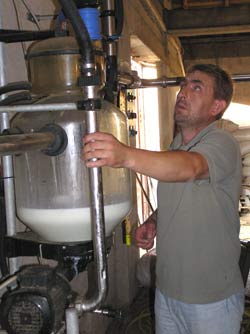You are here » Home » Telling Our Story
Success Story
Efficient, healthy feed rations improve production and sales
Better Feed Brings Milk and Income

| |
Photo: Arben Musliu, Chemonics International
|
|
As morning milking starts, Osman Mazreku makes sure the pumps move the milk to the tank outside the barn.
In six weeks the Mazrekus saw their monthly income double - an increase of some $8,500.
|
Osman Mazreku and his family had invested over $600,000 in their new dairy. Now Osman wished he had their money back: his cows were underweight and, producing only 10.5 liters of milk a day, they were losing money.
Osman, his brother Azem and his father Sadri had built the dairy in Malisheve/Malisevo (the town's Albanian/Serbian names) in November 2004. They had no experience in milk production or managing a dairy farm. By their own admission, they were not cattle people. But they knew that Kosovo imported a large percentage of its milk, that agriculture was a key to the Kosovo economy and that a business opportunity existed in dairy farming. They invested in 100 Simmental cows. Yet after four months, milk production was well below the breed average of 25-30 liters a day.
When USAID first visited the farm in March 2005, Mazreku was marketing 1,050 liters of milk a day - an extremely poor average that indicated the cows were literally being starved to death. The Mazrekus admitted they didn't know how to feed the animals properly and were convinced that if milk production failed to increase, the dairy would go bankrupt.
A USAID dairy nutritionist developed the most cost-effective rations to benefit the Mazrekus and other Kosovo dairies. Better feed quickly improves milk production and the cows' health. In addition, milk fat percentage and milk quality improve - two components for which processors pay a premium. Working with the Kosovo Association of Milk Producers, USAID showed farmers that the best ration is the one that makes the dairy producer the most money, not necessarily the cheapest one.
Print-friendly version of this page (244kb - PDF)
Click here for high-res photo
Back to Top ^ | 

